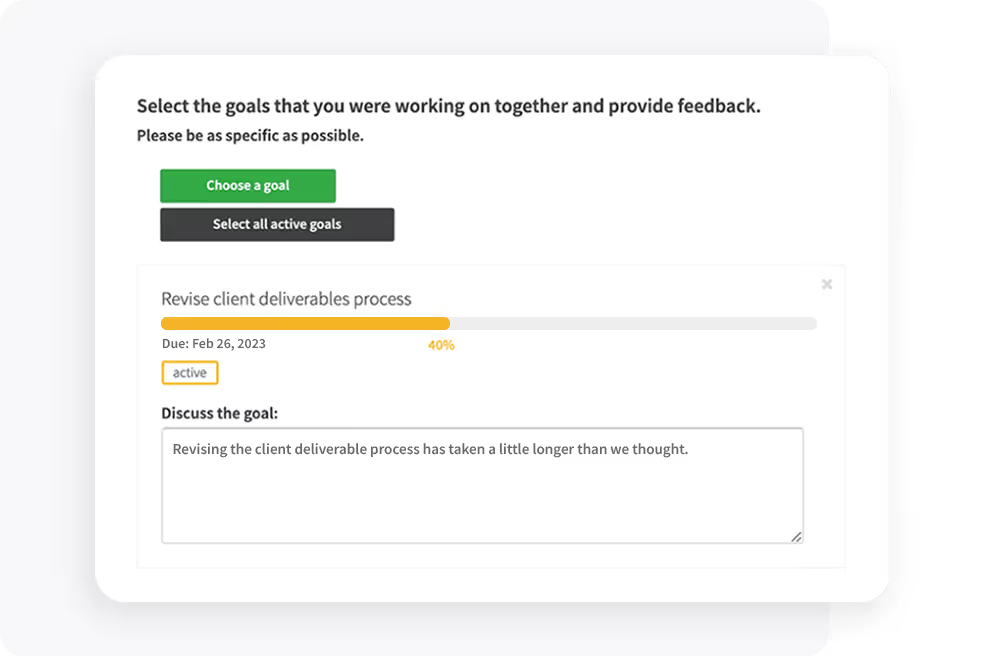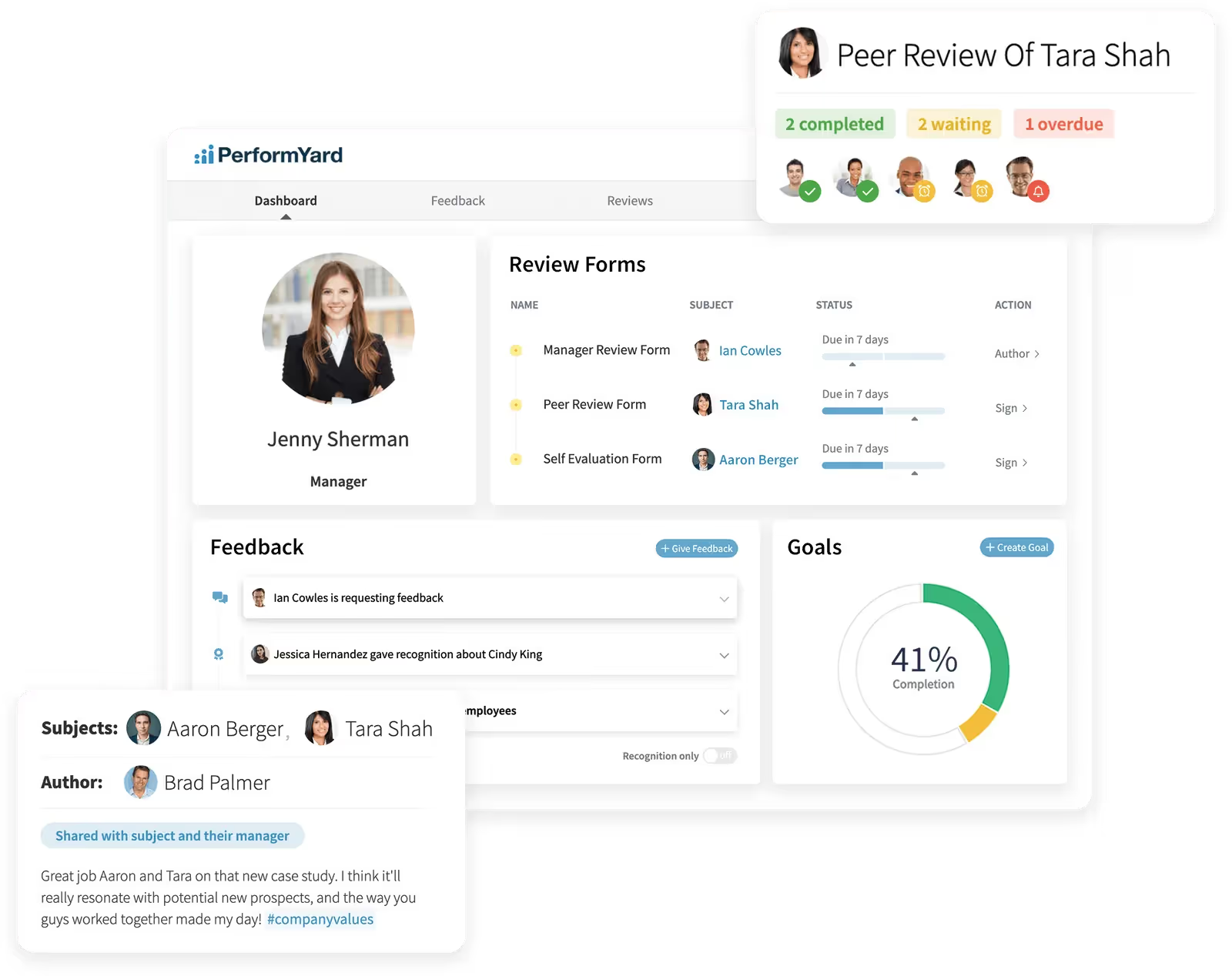What Is the GROW Coaching Model and How to Use It?
The GROW Coaching Model is a great option for organizations that want to promote a growth mindset culture in the workplace.
It’s a structured coaching framework for setting realistic, clear goals and helping employees achieve them by clarifying objectives and predicting obstacles. It facilitates improved decision-making, it has the potential to increase motivation, and it can even increase the likelihood that employees will achieve their goals.
Here at PerformYard, we know a thing or two about what it takes to best support your employees, their goals, and their performance. We think the GROW Coaching Model is a great way to approach performance management, but that doesn’t mean it’s for everyone.
Discover exactly what the GROW coaching model is, the benefits that come with it, and how to set up an effective growth-centric system to see if it’s right for you, your business, and your employees.
What is the GROW Coaching Model?
The GROW Coaching Model was developed in the 1980s by business coaching experts Graham Alexander, Alan Fine, and Sir John Whitmore. As pioneers of coaching in the workplace, they developed the program to make a real difference in work environments by showing that you can foster increased performance and support learning and enjoyment at the same time.
The GROW Coaching Model is an acronym that stands for:
- Goal: This is the goal that the employee or team wants to work towards.
- Reality: This step requires coaches and employees to brainstorm how the goal relates to the current reality by focusing on potential obstacles.
- Options: Employees and coaches brainstorm a list of options and solutions to those obstacles.
- Will: Employees map out their goals and develop an action plan they can commit to.
What makes the GROW Coaching Model different from other strategies is that it features a true coaching process. It goes beyond traditional performance management and even mentoring. It is a time-bound process that focuses on reaching specific goals, but it puts employees at the center of the process. It is designed to help them reach their full potential while giving them plenty of control over their goals and how they’re going to achieve them through new skills.
» 10 Workplace Coaching Examples for Employee Development
Benefits of Using the GROW Framework
The GROW Coaching Model can indeed be time-consuming, but all that extra time spent on employees' professional development comes with some serious benefits that include:
- Clarity and focus during the goal-setting process
- Realistic assessment of current circumstances and potential obstacles
- Creative exploration of possible solutions to potential obstacles
- Commitment to taking actionable steps to reach goals
- Accountability throughout the process
The GROW Coaching Model has the potential to improve your performance management process because it emphasizes employee growth and accountability. It can increase employee engagement because they are invested in achieving the goals they created for themselves, with their manager providing support and guidance instead of commanding and controlling. Because of this, it’s also a great executive coaching process, as it provides support to self-driven executives, higher-ups, and bosses in achieving their professional goals.
It’s also a great way to align employee goals with corporate objectives. Because the process is collaborative, both employees and supervisors can brainstorm goals together. It allows teams to meet the current moment and remain flexible and adaptable in a world where business practices, technology, and the economy are evolving more rapidly than ever.
GROW Model Coaching Template
Managers and HR professionals can use a simple template to guide their GROW coaching sessions. Below is a reusable table format that outlines each stage of GROW with its focus and some guiding questions:
Use this template as a checklist or worksheet during coaching conversations. By consistently structuring discussions with the GROW model, managers can ensure coaching time is focused and effective. Over time, this approach helps build a culture where employees are supported in setting goals, finding solutions, and taking ownership of their development.
How to Use the GROW Coaching Model
The GROW Coaching Model is a relatively straightforward process, which is one of the reasons why it’s so powerful, but there are a few things to keep in mind before diving into the nitty-gritty of the GROW framework.
First, it can be helpful to decide on a topic ahead of your meeting. It gives employees the chance to brainstorm potential goals ahead of the meeting while setting the stage for a focused coaching conversation. It's also a great way to develop a topic that aligns with business objectives.
Active listening and open-ended questions are imperative to the process. Employees must get on the floor to share their ideas and answer non-leading questions.
The GROW Coaching Model includes the following steps:
- Goal
- Reality
- Options
- Will
Goal
Goal management is the first step in the GROW framework. Most employees will already know which specific goal they want to achieve, especially if you've already provided them with a topic, but they may not. You should have a broader goal-setting conversation about the team's goals and how they could relate to personal goals.
Talk about SMART goals during this part of the process to ensure the coachee's goals are specific, measurable, achievable, realistic, and time-bound.
Some coaching questions you should ask during this stage include:
- What do you want to achieve?
- How will you know when you have achieved it?
- What is the timeline for achieving this goal?

Reality
This step is an often overlooked part of other processes, but it’s partly what makes the GROW Coaching Model so effective. It gives each team member a chance to talk about their current situation, in addition to limitations that could potentially prevent them from meeting their goal.
For example, an employee might not have the experience or training they need to meet their personal development goal. They might not have access to the right technology programs, or they may not have enough time in their current schedule to tackle their goal.
A few example questions you should ask during this "reality check" stage include:
- How important is this goal to you?
- What is happening at the moment that could prevent you from meeting this goal?
- Is there anything you're currently doing that's helping you work towards this goal already?
- Will anyone else be affected as you work towards this goal?
Options
The next step in the process enables you to expand on the current reality and come up with solutions to the potential obstacles you uncovered. During this portion of the coaching session, managers help employees identify potential stakeholders and determine if there is more than one way to potentially achieve the goal.
Make sure employees do most of the talking during this step. Guide them in the right direction and make suggestions, but don't make any decisions for them. Let them brainstorm all possible options and help them determine the one they think gives them the highest chance of getting better results and successfully meeting their goal.
Coaching questions to ask during this stage include:
- What are all the possible options for moving forward with your goal?
- What resources do you have available to you?
- Is there anyone who could help you achieve your goal?
- What resources will you need to meet your goal?
Will
This stage of the GROW model is also sometimes referred to as the way forward stage because it is meant to outline exactly how to achieve the goal. During this step, managers develop an action plan that contains exactly what they'll do, whether it’s looping in other team members, getting organized, improving their coaching skills, or developing a project plan.
Creating a schedule of check-in meetings during this stage can be helpful too. It can help keep employees accountable, but it also supports them. Check-in meetings allow you to work out any kinks and celebrate small wins along the way.
Some example questions you can ask during this stage include:
- How will you do it?
- When will you take your action steps?
- How easy or hard will it be for you to commit to that?
- What else could you do to support yourself during the process?
Best Practices When Using the GROW Model
No performance management system is guaranteed to be a success. Whether or not it is effective is often in the details. When it comes time to use GROW coaching tools, it starts with effective prompting and active listening.
The GROW Coaching Model is a true performance coaching system, which means leaders ask open-ended questions to help employees make discoveries and decisions for themselves. Coaches should spend the majority of the time listening and brainstorming ideas to provide the best support.
You also have to be flexible and adaptable in your coaching approach. Setting up a system of continuous feedback through PerformYard’s platform can be especially helpful because it gives employees the power to discuss challenges along the way and pivot, if necessary.
The less stringent you are about following an exact process, the better. The GROW model was created to be flexible when coaching for performance. You do not necessarily have to follow the order of the framework. Support conversations where employees move between all four elements in any order. That could mean revisiting goals after discussing the reality of the situation or revisiting options when an action plan doesn't fit quite right.
It’s also possible that a goal becomes outdated before it’s completed. Having a plan for future employee review meetings, as well as a quick and easy way to give and receive feedback, helps keep everyone on track. It also makes employees feel supported along the way, so goal achievement is more likely.
Integrating PerformYard into the GROW Coaching Model
Implementing a GROW Coaching Model at your organization can be intimidating, but it is an effective performance management strategy. Not only can it support individual employees in reaching their goals, but it can also impact project management and create a supportive atmosphere where employees are encouraged to take ownership of their performance.
PerformYard is a great performance management software tool that can help streamline the process and support the implementation of the GROW model.
Our platform supports goal setting, continuous feedback, and flexible performance reviews. It’s a performance review software that works for you and your team.
Get a demo to see how PerformYard can help you set up a GROW performance management system at your organization.

Ready to Implement a GROW Coaching Model?
The GROW Coaching Model is a popular and effective performance management strategy because it focuses on giving employees ownership over their development. Leaders act like coaches, providing support and guidance so employees feel empowered and supported to reach their goals. It can be a great way to enhance performance, reach organizational goals, and support employees on their professional journeys.
If you’re looking for an easy way to integrate the GROW framework into your performance management system, try PerformYard. Feel free to contact our performance consultants, download our demo, or learn more about our flexible platform that enables you to personalize the right performance management process for your team.


.jpg)

.jpg)
